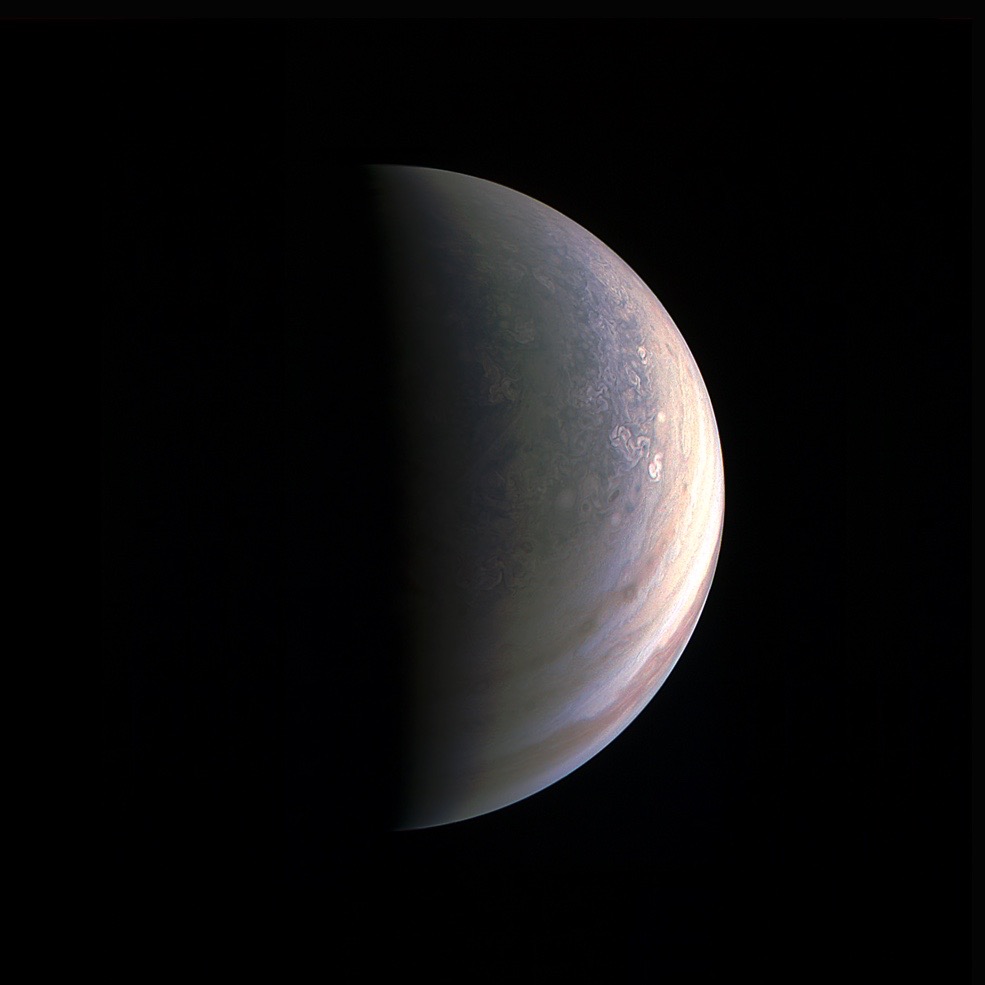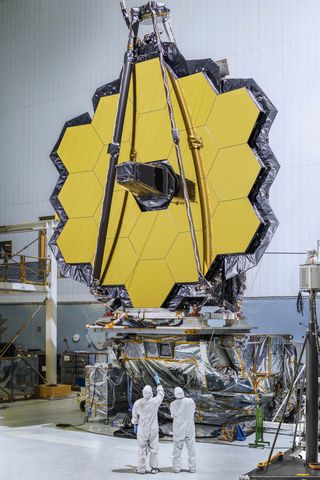NASA's Biggest Space Feats of 2016

It's been a busy year for NASA, which has been pushing frontiers in robotic space exploration, human missions, scientific research and more. Here are some of the projects that the space agency pursued in 2016.
Solar system
NASA's Juno spacecraft successfully reached Jupiter on July 4. While robotic spacecraft have visited the planet many times before, Juno will focus on learning more about the gas giant's atmosphere, magnetosphere, origins and structure.
The agency also launched an asteroid-sampling mission called Origins, Spectral Interpretation, Resource Identification, Security-Regolith Explorer (OSIRIS-Rex). The probe is heading out to visit asteroid Bennu and is expected to return in 2023 with a sample of the space rock, which will help scientists better understand the early solar system.
Construction of the James Webb Space Telescope was completed in November, putting the largest-ever space telescope right on track for its launch date in 2018. The instrument's primary mirror segment was assembled in February at NASA's Goddard Space Flight Center in Maryland. Now the telescope — which is expected to reveal information about the origins of the universe — is being readied for transport to NASA's Johnson Space Center in Houston, where the instrument will undergo pre-launch tests in 2017.

NASA's Wide Field Infrared Survey Telescope (WFIRST) got the formal thumbs-up to start the mission design this year. Using a Hubble-class telescope that once was intended for spying, the mission will allow astronomers to study dark matter, dark energy and the universe's evolution. WFIRST is expected to launch in the mid-2020s.
The Kepler mission, which searches for planets outside the solar system, verified 1,284 newfound alien planets in May of this year. Kepler's long-term goal is to find a planet like Earth, circling a star like the sun.
Closer to home, NASA's Hubble Space Telescope caught a glimpse of the elusive water vapor plumes erupting from Europa, Jupiter's icy, ocean-harboring moon. Europa's underground ocean has twice as much water as Earth and could be a good spot to look for life.
Get the Space.com Newsletter
Breaking space news, the latest updates on rocket launches, skywatching events and more!
NASA's long-running robotic missions Cassini (at Saturn) and New Horizons (which flew by Pluto in 2015) also achieved major milestones. Cassini entered its final year of operations and is looking at Saturn's rings up-close before a planned crash into the planet in April 2017. New Horizons beamed the last of its Pluto data to Earth in October and is currently sailing on to a Kuiper Belt object known as 2014 MU69, which the probe will reach in 2019.
Other milestones include:
- Research in May showing that solar explosions may have sparked life on Earth 4 billion years ago
- NASA's Magnetospheric Multiscale (MMS) winning a Guinness World Record for the highest altitude fix of a GPS signal, at 43,500 miles (70,000 kilometers)
- Reorganizing of NASA's near-Earth object tracking program under the new Planetary Defense Coordination Office
International Space Station
Two space travelers — NASA astronaut Scott Kelly and Russian cosmonaut Mikhail Kornienko — concluded nearly a year in space (340 days) on March 1, when the men returned safely to Earth. NASA astronaut Peggy Whitson, who arrived at the International Space Station (ISS) in November, is set to become the U.S. astronaut with the most cumulative time spent in space, exceeding Jeff Williams' record of 534 days, achieved in 2016. Whitson will also be the first woman to command the ISS twice.
Orbital ATK and SpaceX successfully launched four missions to the ISS in 2016 replete with supplies and equipment. Two of the most notable experiments were Saffire-I and Saffire-II, which examined fire in microgravity inside uncrewed Cygnus spacecraft after they'd undocked from the space station and were falling back to Earth. Also, a billion base pairs of DNA were sequenced for the first time by astronauts aboard the orbiting lab. Three Russian and one Japanese cargo re-supply missions also launched to the space station, but one Russian Progress spacecraft failed during launch, in December.
An inflatable module called BEAM (Bigelow Expandable Activity Module) was successfully deployed on the ISS in May on the second try. The module will run for two years to test whether it is feasible to use inflatables on deep-space missions. [An Inflatable Space Room: The Bigelow Expandable Activity Module in Pictures]
The Commercial Crew Program continues as Boeing and SpaceX do the final designs, manufacturing and testing of their vehicles to launch crewed spacecraft from U.S. soil. The ISS will also undergo changes to accommodate the new spacecraft, like the International Docking Adapter installed earlier this year.
Journey to Mars
NASA has said it hopes to send humans to Mars in the 2030s. The agency is still selecting the next class of astronauts, who will be flying into space during that time frame and will arrive at NASA in summer 2017 for training. A record-breaking 18,300 Americans applied to become astronauts in 2016.
Meanwhile, the Space Launch System — NASA's next-generation rocket for deep-space missions — is still expected to launch in late 2018, along with the Orion spacecraft. The Kennedy Space Center has been upgraded to support this flight.
NASA's Asteroid Redirect Mission hit a milestone in August when it left the planning phase and moved on to further design and development. It's possible that cubesats, or microsatellites, will fly along with this mission, following on from 13 cubesats expected to launch with the SLS and Orion in 2018.
While the Insight lander's 2016 launch to Mars was delayed, the spacecraft is now on track for a landing in 2018 to put a drill in the planet's surface. The Mars 2020 rover has been approved for final design and construction. NASA has also asked five private spaceflight companies to come up with concepts for a potential future Mars orbiter, which will include upgrades in telecommunications and will provide high-resolution images of the Red Planet.
The Curiosity rover found chemicals suggesting that Mars had more oxygen in its distant past than it does now. The rover also looked at active sand dunes and picked its own rock targets using a laser spectrometer. Two Mars rovers, Curiosity and Opportunity, also tested a radio relay with the European Trace Gas Orbiter after that probe's arrival at Mars in November.
The Mars Reconnaissance Orbiter (MRO) is being used to take high-resolution pictures of potential landing sites for future human and robotic missions. Scientists are looking at seasonal dark streaks called recurring slope lineae, which are possible signs of liquid water. MRO also found evidence of an ice deposit beneath the Utopia Planitia feature on Mars; the deposit contains as much water as Lake Superior (the largest Great Lake.)
Earth, aeronautics, tech and public outreach
NASA's Earth-observing activities include:
- Looking at global sea-level rise with the new Jason-3 mission, which will also help the National Oceanic and Atmospheric Administration (NOAA) better forecast tropical cyclones
- Launching Geostationary Operational Environmental Satellite-R (GOES-R) on Nov. 19: The satellite is expected to improve weather-forecasting capabilities.
- Launching the Cyclone Global Navigation Satellite System (CYGNSS) mission on Dec. 15: The mission sent a swarm of eight satellites to study weather patterns and improve hurricane forecasts.
- Preparing the Stratospheric Aerosol and Gas Experiment III (SAGE III) experiment, which will document Earth's ozone layer, for launch: Both Sage III and another storm-monitoring instrument, called the Lightning Imaging Sensor (LIS), will launch to the International Space Station next year.
- Learning how much water is stored on planet Earth through the Gravity Recovery and Climate Experiment (GRACE) twin satellites
NASA's aeronautics research activities include:
- Developing a passenger jet called QueSST that flies at supersonic speeds without creating a sonic boom
- Testing "green" technologies with X-planes, such as the X-57 Maxwell, an experimental aircraft that has 14 propellers
- Partnering with the Department of Transportation to streamline airplane traffic at Charlotte Douglas International Airport as part of the Obama administration's NextGen initiative
- Testing how to safely manage traffic for uncrewed aircraft systems by flying 22 drones at six test sites across the country
- Selecting five green aviation-technology concepts for further study, including alternative fuel cells and ways to change an aircraft wing's shape in flight
NASA's technology work includes:
- Choosing three companies to develop the technology for robotic manufacturing and assembly in orbit
- Pushing forward research on solar electric propulsion, which will cut spaceflight costs by using more efficient technology and which has already been demonstrated in space on the Dawn mission to the asteroid belt
- Launching a self-contained, wax-based heat exchanger to the ISS to better regulate temperatures in spacecraft
- Moving dozens of NASA's patents into the public domain
NASA's citizen science and public activities include:
- Participating in many public events, including those related to the "Star Trek" 50th anniversary
- Communicating via social media: NASA's 20 million followers on Twitter make it the most-followed agency in the federal government. The agency also started using Snapchat, Pinterest and GIPHY.
- Launching 28 citizen scientist challenges, which brought in almost 122,000 participants: Some of these challenges included a Vascular Tissue Challenge for regenerative medicine on long-term space missions and the "Star Trek" Replicator Challenge for preparing food in space.
- Honoring women, especially African-Americans, who participated in early NASA missions by providing resources and other input for the making of the new movie "Hidden Figures"
Follow Elizabeth Howell @howellspace, or Space.com @Spacedotcom. We're also on Facebook and Google+. Original article on Space.com.
Join our Space Forums to keep talking space on the latest missions, night sky and more! And if you have a news tip, correction or comment, let us know at: community@space.com.

Elizabeth Howell (she/her), Ph.D., was a staff writer in the spaceflight channel between 2022 and 2024 specializing in Canadian space news. She was contributing writer for Space.com for 10 years from 2012 to 2024. Elizabeth's reporting includes multiple exclusives with the White House, leading world coverage about a lost-and-found space tomato on the International Space Station, witnessing five human spaceflight launches on two continents, flying parabolic, working inside a spacesuit, and participating in a simulated Mars mission. Her latest book, "Why Am I Taller?" (ECW Press, 2022) is co-written with astronaut Dave Williams.











